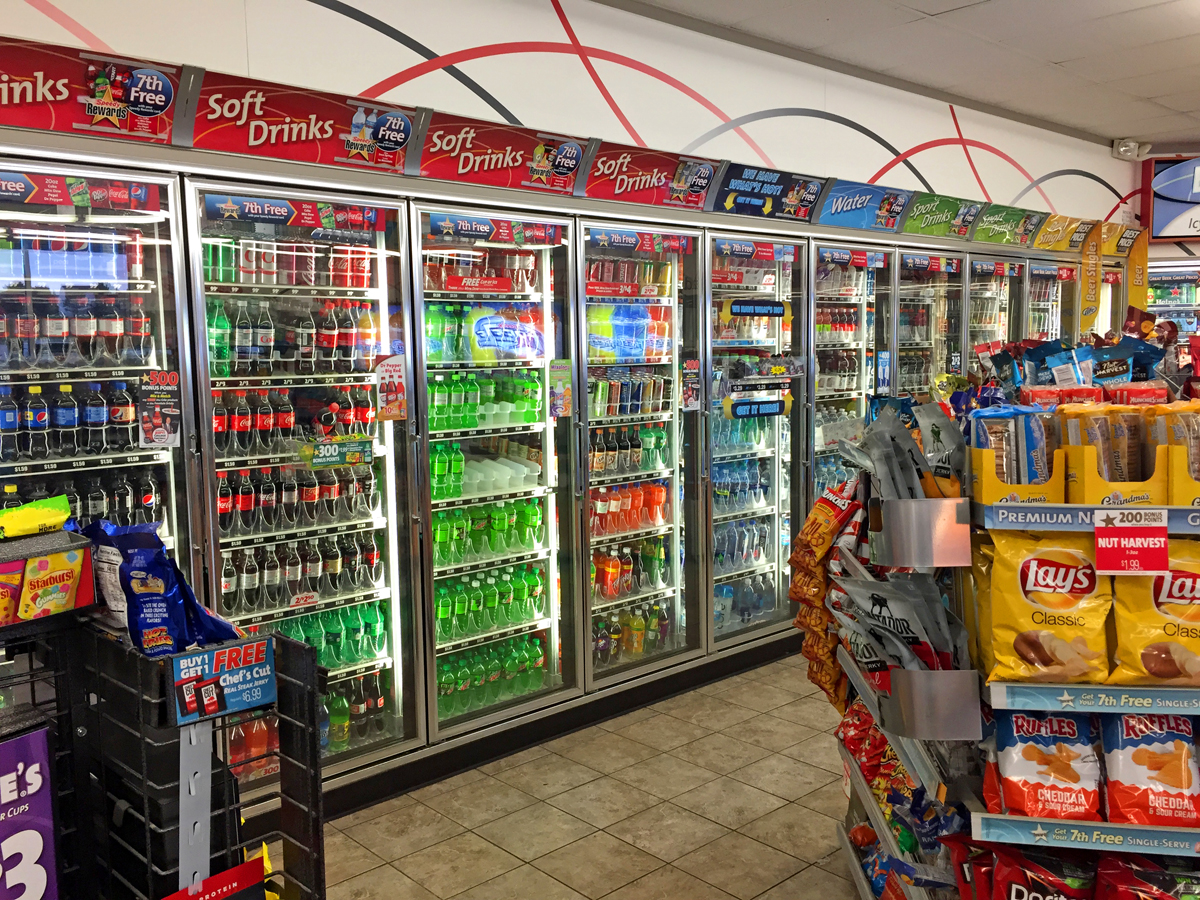Rolling south on I-75 and suddenly the Flying J pizza I grabbed for lunch comes back to haunt me. Nausea, yuck. I downshift at the next exit and circle in to a Speedway to buy a ginger ale, the common remedy. Inside the Speedway, LED-lit coolers enclose Pepsi and Coke-type beverages, but there’s no ginger ale. Obviously, ginger ale’s two popular makers – Cadbury Schweppes and the American Dr. Pepper Snapple Group – don’t contract with Speedway.
Damn.
You’ve read of drowning men grasping at straws? I pick a Sprite, Coca-Cola’s 7Up knockoff, as a substitute cure. And, appreciating that I’ll soon feel better, I add two Krispy Kreme donuts.
In an August 2010 paper, Michigan State Univ. professor Philip H. Howard wrote that three firms control 89% of US soft drink sales. Most interesting, he noted, “This dominance is obscured from us by the appearance of numerous choices on retailer shelves.” His report is supported by Investopedia.com, which says Coca-Cola Co. owns, licenses and markets more than 500 beverage brands. The site also says PepsiCo owns 22 brands that each exceed a billion dollars in annual sales. Pepsi’s assembly includes Frito-Lay, Quaker (Gatorade), Tropicana, Lipton and a Starbucks partnership.
Coca-Cola’s website records even more diversity. It recently said, “By early 2013, the buzz surrounding wearable technology caught the attention of the Coca-Cola Company’s Strategic Marketing Venture team, which invests in high-potential startups aligned with Coke’s core business, including digital music streaming service Spotify, social fitness community Endomondo and music licensing firm Music Dealers.”
Such diverse companies are often identified by words only the big- money guys toss around, for example: monopoly, oligarchy and oligopoly. The most familiar, “monopoly,” describes a company that has full control over a product realm or service. “Oligarchy” defines a small government or power faction that exercises total control over its influence sphere.
Advertisement
“Oligopoly,” Investopedia.com says, is a business construct in which a small number of firms holds the largest portion of market share, which allows them to “set prices and increase profit margins above what a truly free market would allow.” As a consequence of such control, oligopolies can either cost you money, limit your buying choices or both. Their influence is far-reaching and can affect your buying options and budget, especially when buying wholesale plastics and metals, but also in major software or computer purchases.
The most evident oligopolies are airlines, banks, pharmaceutical makers, cellphone makers and services, food producing corporations, energy companies, oil companies, auto makers, cable television, computer and software producers, and entertainment production companies. Thus, if you buy soda, eat potato chips, own a cell- phone, search Google, fly commercial airlines, have health insurance or watch movies, you’re being influenced by oligopolistic schemes.
The mechanisms for oligopolistic control are that a small group of such firms sells either homogeneous products (metals, e.g., aluminum, copper, steel or precious metals) or heterogeneous products (airline tickets, potato chips, phones) to a large buying populace. The control dynamic is that few sellers exist in a sizable market, so they, as a power group, dominate the market, create barriers to their competition and control prices, all legally and sans express collusion.
In their book Economics, authors R. Glenn Hubbard and Anthony P. O’Brien said that oligopolies take advantage of anything that keeps new firms from entering an industry. They noted that scale – the lesser costs of high-volume production – is an effective barrier because new firms generally have higher costs than established, high-volume firms. Other barriers are gained through lobbying for government regulations, patent controls, technology licensing and supporting massive advertising programs.
PR Newswire, in a Sept. 21 Research and Markets Metal Organics Compound (MO) report on sources for trimethyl, gallium, trimethyl indium and other materials, said that the related global industry “presents an oligopoly pattern due to high technical barriers.” The report named the key producers as DOW (US) Merck (Germany), AKZO Nobel (Netherlands), Nata Opto-electronic (China) and Ube Industries (Japan).
The report noted that over 80% of MO’s are used in LED lamps.
Advertisement
Important here is to recognize that oligopolies are so huge and widespread that there’s no escape in dealing with them, like my having to buy Sprite instead of the ginger ale I wanted. However, as a parry, you might sometimes try buying outside the popular circle because of potentially better quality and service.


 Tip Sheet1 week ago
Tip Sheet1 week ago
 Ask Signs of the Times2 days ago
Ask Signs of the Times2 days ago
 Real Deal1 week ago
Real Deal1 week ago
 Benchmarks4 days ago
Benchmarks4 days ago
 Editor's Note2 weeks ago
Editor's Note2 weeks ago
 Women in Signs1 week ago
Women in Signs1 week ago
 Photo Gallery6 days ago
Photo Gallery6 days ago
 Product Buying + Technology2 weeks ago
Product Buying + Technology2 weeks ago
















